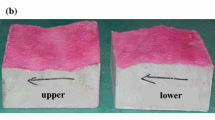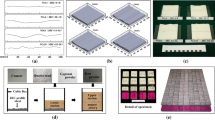Abstract
Natural rock joints are rarely dry or saturated. It is therefore essential to quantitatively assess the influence of varying saturations on shear properties of rock joint. In this study, to guarantee the test repeatability, artificial rock joints with various roughness coefficients (JRCs) of 0, 7.3, 10.1, and 12.9 are firstly reproduced by utilizing rock-like materials. Then, direct shear experiments are performed on the duplicated joint samples at various moisture conditions ranging from dry to saturation, while under a constant normal stress of 0.2 MPa. Obviously, it is noticed that the shear strength of joint sample declines with an increment in joint saturation. Specifically, when compared to the corresponding dry samples, peak shear strength (PSS) of saturated samples with JRCs of 12.9, 10.1, and 7.3 decrease by 35.7, 28.5, and 16.1%, respectively. Moreover, the observed weakening influence of joint saturation on its PSS is roughness sensitive, which may be resulted from the changing in water–rock contact areas of joints with different roughness. Besides, the residual shear strength is also observed to decline as joint saturation increases. Furthermore, based on experimental results, a correction factor is proposed and introduced into the classical JRC-JCS shear strength criterion, and the corrected criterion is capable of estimating peak shear strength of joint sample subjected to various saturations. This work can provide some insights into the shear strength evolution of rock joints under varying saturations, and the findings emphasize the importance of considering the moisture content in rock engineering where wetting phase is encountered.
















Similar content being viewed by others
Data Availability Statement
The data that support the findings of this study are available from the corresponding author, Zhen Zhong, upon reasonable request.
References
Alonso EE, Zandarín MT, Olivella S (2013) Joints in unsaturated rocks: thermo-hydro-mechanical formulation and constitutive behavior. J Rock Mech Geotechn Eng 5:200–213
Atapour H, Moosavi M (2013) The influence of shearing velocity on shear behavior of artificial joints. Rock Mech Rock Eng 47:1745–1761
Ban LR, Gao AS, Qi CZ, Yan FY, Ji CM (2020) A modified model for estimating peak shear displacement of artificial joints. Bull Eng Geol Env 79:5585–5597
Barton N, Choubey V (1977) The shear strength of rock joints in theory and practice. Rock Mech 10:1–54
Barton N, Bandis S, Bakhtar K (1985) Strength, deformation and conductivity coupling of rock joints. Int J Rock Mech Min Sci Geomech Abstr 22:121–140
Baud P, Zhu WL, Wong TF (2000) Failure mode and weakening effect of water on sandstone. J Geophys Res 105:16371–16389
Bian K, Liu J, Zhang W, Zheng XQ, Ni SH, Liu ZP (2018) Mechanical behavior and damage constitutive model of rock subjected to water-weakening effect and uniaxial loading. Rock Mech Rock Eng 52:1–10
Bidgoli MN, Jing L (2015) Water pressure effects on strength and deformability of fractured rocks under low confining pressures. Rock Mech Rock Eng 48:971–985
Chen YD, Zhang CY, Zhao ZH, Zhao XG (2020) Shear behavior of artificial and natural granite fractures after heating and water-cooling treatment. Rock Mech Rock Eng 53:5429–5449
Cherblanc F, Berthonneau J, Bromblet P, Huon V (2016) Influence of water content on the mechanical behavior of limestone: role of clay minerals content. Rock Mech Rock Eng 49:2033–2042
Dou ZH, Gao TY, Zhao ZH, Li JJ, Yang Q, Yi S (2021) Effect of immersion duration on shear behavior of granite fractures. Rock Mech Rock Eng 54:4809–4823
Dove PM (1995) Geochemical controls on the kinetics of quartz fracture at subcritical tensile stresses. J Geophys Res Atmosph 1002(B11):22349–22359
Deere DU, Miller RP (1966) Engineering classification and index properties for intact rock. Technical Report No. AFNL-TR-65- 116. Air Force Weapons Laboratory, New Mexico
Erguler ZA, Ulusay R (2009) Water-induced variations in mechanical properties of clay-bearing rocks. Int J Rock Mech Min Sci 46:355–370
Feng XT, Chen S, Li S (2001) Effects of water chemistry on microcracking and compressive strength of granite. Int J Rock Mech Min Sci 38:557–568
Feucht LJ, Logan JM (1990) Effects of chemically active solutions on shearing behavior of a sandstone. Tectonophysics 175:159–176
Gong LB, Nemcik J, Ren T (2018) Numerical simulation of the shear behavior of rock joints filled with unsaturated soil. Int J Geomech 18(9):04018112
Grant MA, Donaldson IG, Bixley PF (1983) Geotherm Reservoir Eng. Academic Press, New York
Gutierrez M, Ino LE, Heg K (2000) The effect of fluid content on the mechanical behavior of fractures in chalk. Rock Mech Rock Eng 33:93–117
Hans J, Boulon M (2003) A new device for investigating the hydro-mechanical properties of rock joints. Int J Numer Anal Meth Geomech 27:513–548
Indraratna B, Premadasa W, Brown ET (2013) Shear behavior of rock joints with unsaturated infill. Géotechnique 63(15):1356–1360
Jaeger JC (1959) The frictional properties of joints in rock. Geofis Pura Appl 43:148–158
Jaeger JC, Cook N, Zimmerman R (2009) Fundamental of Rock Mechanics, 4th edn. Wiley-Blackwell, Oxford
Karfakis MG, Akram M (1993) Effects of chemical solutions on rock fracturing. Int J Rock Mech Min Sci Geomech Abstracts 30:1253–1259
Khosravi A, Serej AD, Mousavi SM, Haeri SM (2016) Effect of hydraulic hysteresis and degree of saturation of infill materials on the behavior of an infilled rock fracture. Int J Rock Mech Min Sci 88:105–114
Kim T, Jeon S (2019) Experimental study on shear behavior of a rock discontinuity under various thermal, hydraulic and mechanical conditions. Rock Mech Rock Eng 52:1–20
Lajtai EZ, Schmidtke RH, Bielus LP (1987) The effect of water on the time-dependent deformation and fracture of a granite. Int J Rock Mech Min Sci Geomech Abstr 24:247–255
Li N, Zhu YM, Su B, Gunter S (2003) A chemical damage model of sandstone in acid solution. Int J Rock Mech Min Sci 40:243–249
Li B, Ye XN, Dou ZH, Zhao ZH, Li YC, Yang Q (2020) Shear strength of rock fractures under dry, surface wet and saturated conditions. Rock Mech Rock Eng 53:1–18
Li B, Bao RY, Wang Y, Liu RC, Zhao C (2021) Permeability evolution of two-dimensional fracture networks during shear under constant normal stiffness boundary conditions. Rock Mech Rock Eng 54:1–20
Liu JS, Cao P, Liu J, Fan JX, Ning GG, Li FL (2017) Effect of temperature–water coupled actions on joint morphology. Geotech Geol Eng 35:1–9
Nara Y, Hiroyoshi N, Yoneda T, Kaneko K (2010) Effects of relative humidity and temperature on subcritical crack growth in igneous rock. Int J Rock Mech Min Sci 47:640–646
Nouailletas O, Perlot C, Rivard P, Ballivy G, Borderie CL (2017) Impact of acid attack on the shear behavior of a carbonate rock joint. Rock Mech Rock Eng 50:1–13
Pellet FL, Keshavarz M, Boulon M (2013) Influence of humidity conditions on shear strength of clay rock discontinuities. Eng Geol 157:33–38
Roy DG, Singh TN, Kodikara J, Das R (2017) Effect of water saturation on the fracture and mechanical properties of sedimentary rocks. Rock Mech Rock Eng 50:1–16
Rubinstein JL, Mahani AB (2015) Myths and facts on wastewater injection, hydraulic fracturing, enhanced oil recovery, and induced seismicity. Seismol Res Lett 86:1060–1067
Rutter E, Hackston A (2017) On the effective stress law for rock-on-rock frictional sliding, and fault slip triggered by means of fluid injection. Phil Trans Royal Soci A Math Phys Eng Sci 375:20160001
Shang DL, Zhao ZH, Dou ZH, Yang Q (2020) Shear behaviors of granite fractures immersed in chemical solutions. Eng Geol 279:105869
Shrivastava AK, Rao KS (2015) Shear behavior of rock joints under CNL and CNS boundary conditions. Geotech Geol Eng 33:1205–1220
Tang ZC, Zhang QZ, Peng J, Jiao YY (2019) Experimental study on the water-weakening shear behaviors of sandstone joints collected from the middle region of Yunnan province P.R. China. Eng Geol 258:105161
Tse R, Cruden DM (1979) Estimating joint roughness coefficients. Int J Rock Mech Min Sci Geomech Abstr 16:303–307
Ulusay R, Hudson JA (2007) The complete ISRM suggested methods for rock characterization, testing and monitoring: 1974–2006, ISRM, Springer, Switzerland
Ulusay R, Karakul H (2016) Assessment of basic friction angles of various rock types from Turkey under dry, wet and submerged conditions and some considerations on tilt testing. Bull Eng Geol Env 75:1683–1699
Van Eeckhout EM (1976) The mechanisms of strength reduction due to moisture in coal mine shales. Int J Rock Mech Min Sci Geomech Abstr 13:61–67
Wang F, Cao P, Cao RH, Xiong XG, Hao J (2019) The influence of temperature and time on water-rock interactions based on the morphology of rock joint surfaces. Bull Eng Geol Env 78:3385–3394
Wasantha PLP, Ranjith PG (2014) Water-weakening behavior of Hawkesbury sandstone in brittle regime. Eng Geol 178:91–101
Wong LNY, Maruvanchery V, Liu G (2016) Water effects on rock strength and stiffness degradation. Acta Geotech 11:713–737
Zhang Q, Li XC, Bai B, Hu HX (2019) The shear behavior of sandstone joints under different fluid and temperature conditions. Eng Geol 257:105143
Zhao ZH, Yang J, Zhou D, Chen YF (2017) Experimental investigation on the wetting-induced weakening of sandstone joints. Eng Geol 225:61–67
Zhao ZH, Guo T, Ning Z, Dou Z, Dai F, Yang Q (2018a) Numerical modeling of stability of fractured reservoir bank slopes subjected to water-rock interactions. Rock Mech Rock Eng 51:2517–2531
Zhao ZH, Peng H, Wu W, Chen YF (2018b) Characteristics of shear-induced asperity degradation of rock fractures and implications for solute retardation. Int J Rock Mech Min Sci 105:53–61
Zhao ZH, Dou ZH, Xu HR, Liu ZN (2019) Shear behavior of Beishan granite fractures after thermal treatment. Eng Fract Mech 213:223–240
Zhong Z, Wang L, Song LB, Gao C, Hu YJ, Gao HC, Song F, Rodriguez-Dono A, Lou R (2021) Size effect on the hydraulic behavior of fluid flow through a single rough-walled fracture. Soil Dyn Earthq Eng 143:106615
Acknowledgements
This work was funded by the National Natural Science Foundation of China (grant numbers 41977256, 51509154, and 41907167), the Natural Science Foundation of Zhejiang Province (grant number LGJ20E090001), the International Scientific and Technological Cooperation Projects of Shaoxing University (grant number 2019LGGH1008). All the supports are gratefully acknowledged.
Author information
Authors and Affiliations
Corresponding author
Ethics declarations
Conflicts of interest
On behalf of all authors, the corresponding author states that there is no conflict of interest.
Additional information
Publisher's Note
Springer Nature remains neutral with regard to jurisdictional claims in published maps and institutional affiliations.
Rights and permissions
About this article
Cite this article
Hu, Y., Wang, X. & Zhong, Z. Investigations on the jointed influences of saturation and roughness on the shear properties of artificial rock joints. Geomech. Geophys. Geo-energ. Geo-resour. 8, 115 (2022). https://doi.org/10.1007/s40948-022-00421-2
Received:
Accepted:
Published:
DOI: https://doi.org/10.1007/s40948-022-00421-2




